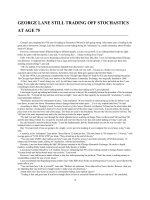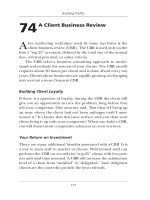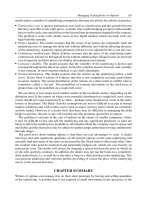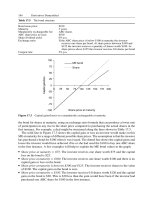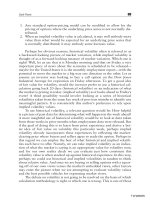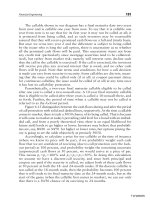STUDY GUIDE FOR COME INTO MY TRADING ROOM phần 8 docx
Bạn đang xem bản rút gọn của tài liệu. Xem và tải ngay bản đầy đủ của tài liệu tại đây (153.59 KB, 20 trang )
NINE
THE ORGANIZED TRADER
Answer 83
Factor 3 is correct. Give yourself three points for choosing the right
answer.
All factors listed here are important, but none more so than disci-
pline. Markets are full of intelligent people with experience and imagi-
nation who have been trained and still fail to make money. Discipline
is the key factor; without it all others are useless.
Answer 84
Choice 2. Give yourself four points for choosing the right answer.
Good records are the key factor in disciplined trading. Keeping them
leads to a reduction in trading mistakes. No matter how good your
records, no matter how proficient you become in trading, nothing per-
mits you to relax your money management discipline; if anything, as
traders get better, they tend to tighten their money management.
Answer 85
E. All of the above. Give yourself four points for choosing the right
answer.
Entry and exit dates and price levels are the basic starting points for
this spreadsheet. It also helps to keep an eye on expenses. A more
133
sophisticated trader uses his spreadsheet to calculate his performance
grade for every trade, that is, the percentage of a trading channel caught
in that trade. He can also rate the quality of entries and exits—whether
he bought or sold closer to the top or the bottom of the daily bar.
Answer 86
C. 1, 2, and 3. Give yourself four points for choosing the right answer.
If you intend to treat trading as a business, you must know its cash
position at any given time. Equity in a trading account consists of the
current value of all open positions, marking open profits and losses to
market, as well as cash and cash equivalents, such as T-bills. Funds out-
side of your trading account, such as savings or credit lines, are imma-
terial to your equity.
Answer 87
Trader 5 has the best equity curve. Give yourself four points for choos-
ing the right answer.
Trader 4 earned the biggest profit, but his drawdown is outright scary.
A $28,000 drawdown represents more than a quarter of this trader’s
starting equity. What if such a deep drawdown comes at the very
beginning of a money management period? No matter how brilliant a
comeback, this kind of trading is an invitation to disaster. Most fund
managers look for steady gains with small drawdowns. If your draw-
down never goes into double digits, your performance is brilliant.
Answer 88
Choice 4 is correct. Give yourself three points for choosing the right
answer.
One chart per entry or exit may not be enough, because entries and
exits tend to be complex affairs with several parameters. You may want
to print out a weekly, a daily and an intraday chart for an entry and a
134 ANSWERS AND RATING SCALES
daily, and an intraday for an exit. Five charts per entry or exit is too
much; trading decisions are best reduced to a small number of key
parameters.
Answer 89
C. 1, 2, and 3. Give yourself four points for choosing the right answer
(two points if you chose D).
Gloating after taking a profit or cringing after taking a loss does noth-
ing to improve future performance. What did I do right? Have I made a
mistake? What should I do differently next time? A focused, disciplined
trader keeps asking himself these and other questions, and a trading
diary helps him answer them. People who have the discipline to keep
good records have the discipline to win consistently. Still, it may be
impractical for a very active trader to keep a diary of every single trade.
In that case, it is important to keep a diary for every second, third, or
fifth trade, in strict order, rather than deciding to keep it for “interesting”
trades and omitting it for “ordinary” trades. Knowing which is which
tends to come well after a trade has been closed out.
Answer 90
Entry—4. 75%.
Exit— 2. 25%.
Give yourself two points for each correct answer.
The entry grade rates the quality of your entry by expressing it as a
percentage of that day’s range. If the high of the day was 48, the low 44,
and you bought at 47, then your entry grade is 75, meaning you missed
75% of the day’s range. The lower the percentage while buying, the bet-
ter. The exit grade rates the quality of your exit. If the high of the day
was 54, the low 50, and you sold at 51, your exit grade is 25. It means
you captured 25% of that day’s range. The higher the percentage, the
better for the seller. The idea is to get your buying grade below 50% and
THE ORGANIZED TRADER 135
your selling grade above 50%. This is much harder to accomplish than
it looks.
Answer 91
C. 1, 2, and 3. Give yourself four points for choosing the right answer
(two points if you chose B).
Rapidly changing prices affect people like the noise and flashing of
slot machines, tempting them to put in another quarter. Making deci-
sions to buy, sell, or stand aside when the markets are closed offers
traders the luxury of time. Comparing your stock or future to others adds
an extra dimension to your decision-making process. It is a bad idea to
ask for advice on specific trades before taking them—those trades are
yours and the decision is yours alone.
Answer 92
1. A
2. B
3. C
4. E
5. D
Give yourself a point for each correct answer.
Having to describe a chart forces you to focus on specific signals that
led to a trading decision. Live charts often seduce traders into joining
emotional crowds; reading your orders from a printed sheet reinforces
discipline. If you planned to buy a stock if it trades flat, but it gaps up
the next morning and you have not planned for it, there is no reason to
trade. When a stock does something you have not anticipated, that is a
clear signal that your decision making was not in gear with the market,
and putting on a trade is not a good idea.
136 ANSWERS AND RATING SCALES
Answer 93
D. 1, 2, 3, and 4. Give yourself four points for choosing the right
answer.
The trader’s spreadsheet provides a basic record of every trade,
including its performance grade. The equity curve tracks the health of
your account as a whole. The trading diary allows you to learn from
visual records of past trades. The action plan helps you face the next
trading day in a calm and disciplined manner. All of these records are
essential for success; only the ABC rating system is optional. You need it
if you track a large number of stocks and futures, but can do without it if
you watch just a handful.
Answer 94
B. 1 and 2. Give yourself four points for choosing the right answer.
Second-guessing a system, or making trading decisions on the basis
of factors which are not included in the system, dramatically increases
the range of options but reduces the likelihood of success. Second-
guessing raises the level of psychological stress, subverts discipline, and
leads to impulsive trading.
Answer 95
C. 1, 2, and 3. Give yourself four points for choosing the right answer.
Telling people about your open positions is like inviting them to
watch you get intimate with your significant other. It will make you
more popular and invite friendly advice on positions you haven’t con-
sidered, none of which is likely to lead to a successful outcome. You
need to be strong enough to shoulder all the responsibility for a trade;
you may discuss it with others only after closing it.
THE ORGANIZED TRADER 137
Answer 96
E. All of the above. Give yourself four points for choosing the right
answer.
Trading requires time just as much as it requires capital. You need to
review all markets in which you are interested at least once a week,
usually on weekends. All open positions have to be reviewed daily. You
need to keep a timetable of all important news that may impact your
market in order to decide whether to hold your position, reduce its size,
or get out. Breakouts from opening ranges can help with entries; weak
prices near the close can give the signal to get out of a trade. The more
time you put into the markets, the more profit they are likely to return
to you.
Answer 97
1. A
2. E
3. C
4. D
5. B
Give yourself a point for each correct answer.
The ABC rating system helps traders use their time more efficiently.
It calls for a weekly review of all markets you track and sorting them
into three groups. A is the most promising, and usually the smallest,
group, where you anticipate a trade the next day. Stocks or futures in
group A must be reviewed in depth daily. B is the group where you
expect a trade within a few days, and its stocks or futures should be
reviewed a few days later. C is the group where you do not anticipate
a trade for a week, and its stocks or futures can be set aside for the rest
of the week.
138 ANSWERS AND RATING SCALES
Answer 98
Combination 4 is correct. Give yourself four points for choosing the
right answer.
Strict money management rules are the keystone of any trading plan;
they allow you to survive and succeed in the long run. A systems trader
must be absolutely strict about his analytic rules, but a discretionary
trader has some degree of flexibility. As long as he analyzes multiple
timeframes and does not trade against his rules, he has some latitude in
choosing his indicators and methods.
Answer 99
Choice 2 is correct. Give yourself four points for choosing the right
answer.
Beginners are attracted by tales of huge profits, but professionals focus
on survival first. This is why any good trading plan is built on the basis
of money management rules. The next goal is to grind out steady profits.
Once that goal is being consistently achieved, we can spend more time
looking for extraordinary opportunities. Then, if our analysis is right and
the market cooperates, we sometimes achieve extraordinary returns.
Answer 100
Sequence 5 is correct. Give yourself four points for choosing the right
answer.
Serious trading begins with good records. They come first because
they allow you to learn from mistakes as well successes, while you
experiment with different techniques. Setting money management rules
and recording your compliance with them is the next most important
step. The third stage is the development of a decision-making tree.
THE ORGANIZED TRADER 139
Rating Yourself
Below 60 Poor. If you failed this test, please go back to the main book,
reread the appropriate chapters, and retake this test. The topic is so
new and so neglected in trading literature that most people are com-
pletely unfamiliar with it. If you master it, you will get far ahead of
the crowd. Return to the recommended chapters, study them, and
retake this test a few days later.
60–72 Excellent. Your understanding of trading records is uncommon!
All that is left now is to set up your own records—and to trade suc-
cessfully!
Required Reading
Elder, Alexander. Come into My Trading Room (New York: John Wiley &
Sons, 2002). See Chapter 8 “The Organized Trader” and Chapter 9
“Trading for a Living.”
140 ANSWERS AND RATING SCALES
SECTION
THREE
LET’S TRADE:
CASE STUDIES
AND QUESTIONS
LET’S TRADE
The longer you trade, the more you learn—practice will make you a
better trader. Be sure to put on many small trades and carefully docu-
ment every entry and exit. Good records allow you to learn from expe-
rience. Trading small will help you keep emotions in check. You will
have plenty of time to increase your trading size once you become a
competent trader.
Remember this paragraph from Come Into My Trading Room:
Keeping good records is the single most important contribution to
your success. If you scrupulously maintain records, review them, and
learn from them, your performance will improve. If, at the same time,
your money management is in place to ensure survival during the
learning process, you’re sure to become a success.
This chapter of the Study Guide offers you an opportunity to prac-
tice making trading decisions and keeping records. Look at the charts
in this chapter as if you saw them in your trader’s diary. Mark up chart
patterns and indicator signals, and write down your comments on the
most important points. Make your trading decision and then turn to
the Answers chapter to compare your notes with mine and grade your
performance.
There are many ways to reach a trading decision. Some serious
traders use fundamental analysis, others technical, some combine both,
while gamblers trade “from the gut.” I like to be aware of the key fun-
damentals, but my favorite method is technical analysis. Price, time,
and volume reflect actions of all market participants—smart and dumb,
143
disciplined and gamblers, rich and poor, long-term and short-term
oriented. Prices and indicators are the footprints of bulls and bears. Let
us practice reading those footprints in order to find our way.
The charts in this section were printed in December 2001, not long
after the disaster of September 11th in New York. In stressful times like
these, when fundamentals shift rapidly, technical analysis really shines.
How to Work with These Case Studies
You will see three charts for each trade—two for the entry and one for
the exit. For the entry, you will have a weekly and a daily chart. The
weekly chart will show about a year and a half of history, a 26-week
EMA (solid), a 13-week EMA (dotted), and MACD-Histogram. The daily
chart, ending on the same day, will show several months of history,
the 22-day and the 13-day EMAs (solid and dotted), a 2-day Force Index,
and MACD-Histogram. For exit and reentry decisions, you will see an
updated daily chart that will, in addition to the above, show a trading
channel centered around the long EMA.
These charts feature some of my favorite indicators, although many
others could be used. It would impossible to show all important indi-
cators in a study guide, especially since serious traders always change
their sets of technical tools. My main goal here is to demonstrate the
need for using multiple timeframes—making a strategic decision on
the weekly chart and tactical choices on the daily chart. I also want to
illustrate the need for combining several indicators—trend-following
and oscillators—to evaluate different aspects of market behavior and
make rational trading decisions.
It is your job to find, mark, and document at least two important trad-
ing signals on each chart. You will receive a point for each correctly
marked signal and bonus points for identifying additional trading sig-
nals. Be sure to document each step that you take.
There are eight sets of charts, covering eight trades. Begin by work-
ing through an entry in one market, and then grade your performance
on that entry. Afterward, work through an exit and grade your perform-
ance again, using rating scales in the Answers section. If you are satis-
fied with your performance, move on to the next trade and repeat this
process. If you find that you have done poorly in a trade, return to Come
144 CASE STUDIES
Into My Trading Room and reread the relevant chapters before going
any further. This process will put you miles ahead of amateurs and gam-
blers who jump into the market with both feet, chasing a quick buck—
and get taken out feet first. Education, record keeping, and caution are
essential for your long-term success, which is the only success worth
having in the financial markets.
Please do not try to complete all eight exercises in a single day. Give
yourself enough time to think, reflect, reread relevant chapters, and
review other charts on your screen. You can take more than a week to
work through these exercises.
Here is the recommended sequence of steps as you move through
eight trades:
1. Look at the Entry Question page, which shows two unmarked
charts—weekly and a daily.
2. Mark two or more trading messages on each chart; make an entry
decision and document it.
3. Go to the Entry Answer page for that trade and grade your entry per-
formance. If the grade is satisfactory (above the pass point), proceed
as directed below; otherwise, return to Come Into My Trading Room
and study the relevant chapters.
4. Go to the Exit Question page, which shows an updated unmarked
daily chart. Quickly cover it with a sheet of paper.
5. Gently move the sheet from left to right, until you uncover the ver-
tical arrow marking the entry into the trade; from that day onward,
move the sheet to the right very slowly, one day at a time, stopping
after you uncover each day.
6. Whenever you see an exit point, based on chart or indicator signals,
mark it; whenever you see a likely reentry point, mark it also. Most
charts have more than one exit and reentry point.
7. Once you reach the right edge of the chart, go to the Exit Answer
page and rate your performance. If the grade is satisfactory (above
the pass point), proceed as directed below; otherwise, return to
Come Into My Trading Room and study the relevant chapters.
8. Proceed to the next trade and repeat the process.
QUESTIONS 145
Technical analysis is partly a science and partly an art—partly objec-
tive and partly subjective. There are two main approaches to using it in
trading—systematic and discretionary. Systematic traders test and auto-
mate every step. Discretionary traders change their tools as markets
evolve. If you are a systematic trader, you will test all the tools and
apply them in an absolutely uniform manner. As a discretionary trader,
I adjust my tools and every once in a while try to anticipate indicator
signals. The trick is to anticipate them ever so slightly, without going too
far out on a limb, and use the protection of money management.
Intelligent traders may disagree about trading signals. This is why a
professional trader is unlikely to get a perfect score on these tests. He
will bring his personality into the picture and interpret markets slightly
differently. Show me an experienced trader with independent judg-
ment, good records, and solid money management, and I will show
you a winner. What if you see some charts in a different light than I do?
I fear an avalanche of e-mails with questions, and not enough hours
in the day to answer all. The only place where we can butt heads and
argue about trades late into the night is in Traders’ Camps. Bring in your
differences, and we will resolve them. Just be sure to keep good records
of your decisions. Now, let’s go look for trades!
146 CASE STUDIES
Trade 1: Oracle Corp ORCL—Entry Question
QUESTIONS 147
Chart Q1-a 26-week and 13-week EMAs, 12-26-9 MACD-lines and MACD-
Histogram
Chart Q1-b 22-day and 13-day EMAs, 12-26-9 MACD-lines and MACD-
Histogram, 2-day Force Index
Mark at least two trading signals on the weekly as well as the daily charts, and make
a trading decision at the right edge. Do not turn this page or look at the Answers pages
until you have documented your decision.
Answer on pages 164–165.
Trade 1: Oracle Corp ORCL—Exit Question
148 CASE STUDIES
You do not get paid for entering trades, you get paid for exiting them.
Beginners spend most of their time looking for trades, but give little
thought to how they will exit. It is a fact that most trades are profitable
at some point, yet despite that, most beginners lose money on most
trades. They lose because they fail to exit at the right time.
This exercise is designed to help you learn to find exit and reentry
points. Cover this chart with a sheet of paper so that you can see only
from its left edge to the point where you entered the trade. Start moving
the sheet of paper slowly to the right. Uncover one day at a time and
stop to look and analyze what you see. If you think that you see a good
exit point, mark it on the chart. Later, on the Answers pages, you will
see several exit and reentry points. You will be able to compare notes
and grade yourself.
entry
long
Chart Q1-c 22-day and 13-day EMAs, channel, 12-26-9 MACD-lines and
MACD-Histogram, and 2-day Force Index
Answer on pages 166–167.
Trade 2: Sun Microsystems SUNW—Entry Question
QUESTIONS 149
Mark at least two trading signals on the weekly as well as the daily charts and make a
trading decision at the right edge. Do not turn this page or look at the Answers pages
until you have documented your decision.
Answer on pages 168–169.
Chart Q2-a 26-week and 13-week EMAs, 12-26-9 MACD-lines and MACD-
Histogram
Chart Q2-b 22-day and 13-day EMAs, 12-26-9 MACD-lines and MACD-
Histogram, 2-day Force Index
Trade 2: Sun Microsystems SUNW—Exit Question
150 CASE STUDIES
entry
long
Chart Q2-c 22-day and 13-day EMAs, channel, 12-26-9 MACD-lines and
MACD-Histogram, 2-day Force Index
Cover this chart with a sheet of paper and start moving it from left to right
until you reach the vertical arrow, marking the day in October when we
went long SUNW. Continue to uncover the chart, one day at a time.
Analyze each day and mark exit and reentry points. Later, on the Answers
pages, you will be able to compare notes and grade yourself.
Putting on a trade is like jumping into a fast-moving river. You have
more control over an entry than over an exit. You can wait to jump in
until you see a perfect or near-perfect point. Getting out is much harder
because of the fast current and rocky shores. When you wait for an
entry, your only risk is a missed opportunity, but there are many oppor-
tunities in the markets. Exits are much more demanding—you want to
allow a stock to move in your favor to its full potential, but you do not
want to risk losing your paper profits.
Answer on pages 170–171.
QUESTIONS 151
Trade 3: Kroll Inc KROL—Entry Question
This company provides corporate security, and it popped up on my
“radar screen” shortly after the September 11 disaster.
Mark at least two trading signals on the weekly as well as the daily charts and make a
trading decision at the right edge. Do not turn this page or look at the Answers pages
until you have documented your decision.
Answer on pages 172–173.
Chart Q3-a
Chart Q3-b
Trade 3: Kroll Inc KROL—Exit Question
As usual, cover this chart with a sheet of paper and move it slowly from
left to right, one day at a time. Analyze each day and mark likely exit
and reentry points—there are always several of those per trade. Later,
on the Answers pages we will review them, and you will earn points for
each correctly identified exit point.
We went long KROL in the area marked by an arrow in September.
Now we have to decide where to get out of this trade. This is a difficult
question in a trade that is based partly on fundamentals and partly on
technical factors. The fundamental underpinnings mean that we have to
give the bulls the benefit of the doubt and not be in too much of a hurry
to exit. At the same time, we must put the ultimate trust in our techni-
cal indicators and use them to exit a trade.
152 CASE STUDIES
entry
long
Chart Q3-c 22-day and 13-day EMAs, channel, 12-26-9 MACD-lines and
MACD-Histogram, 2-day Force Index
Answer on pages 174–175.
